Enhancing Critical Thinking Skills: A Study in Higher Education
VerifiedAdded on 2020/02/24
|8
|1678
|65
Essay
AI Summary
This paper delves into the crucial topic of critical thinking skills within the context of higher education. It explores various instructional techniques designed to foster active learning and intellectual development, including case studies, discussions, and questioning methods. The paper emphasizes the importance of critical thinking as a fundamental skill across disciplines and examines how students can learn and demonstrate these higher-order thinking skills. It discusses critical thinking development through practice, the components of a critical thinking assessment, and mechanisms for enhancing capabilities, such as answering different types of questions, classroom discussions, pros and cons exercises, and academic research. The paper concludes by highlighting the need for problem-solving skills in modern society and the role of critical thinking in providing viable solutions to various problems. It references several academic sources to support its arguments.
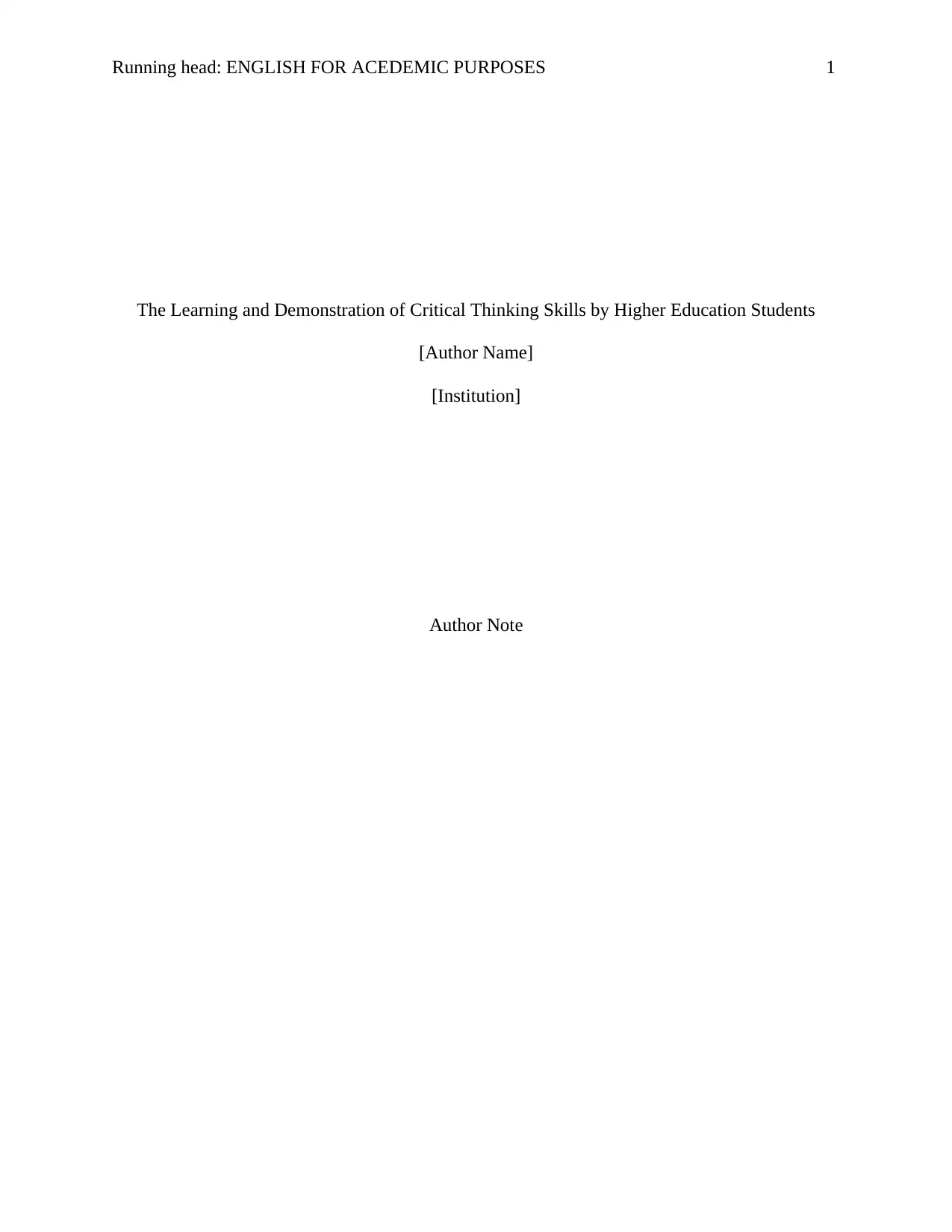
Running head: ENGLISH FOR ACEDEMIC PURPOSES 1
The Learning and Demonstration of Critical Thinking Skills by Higher Education Students
[Author Name]
[Institution]
Author Note
The Learning and Demonstration of Critical Thinking Skills by Higher Education Students
[Author Name]
[Institution]
Author Note
Paraphrase This Document
Need a fresh take? Get an instant paraphrase of this document with our AI Paraphraser
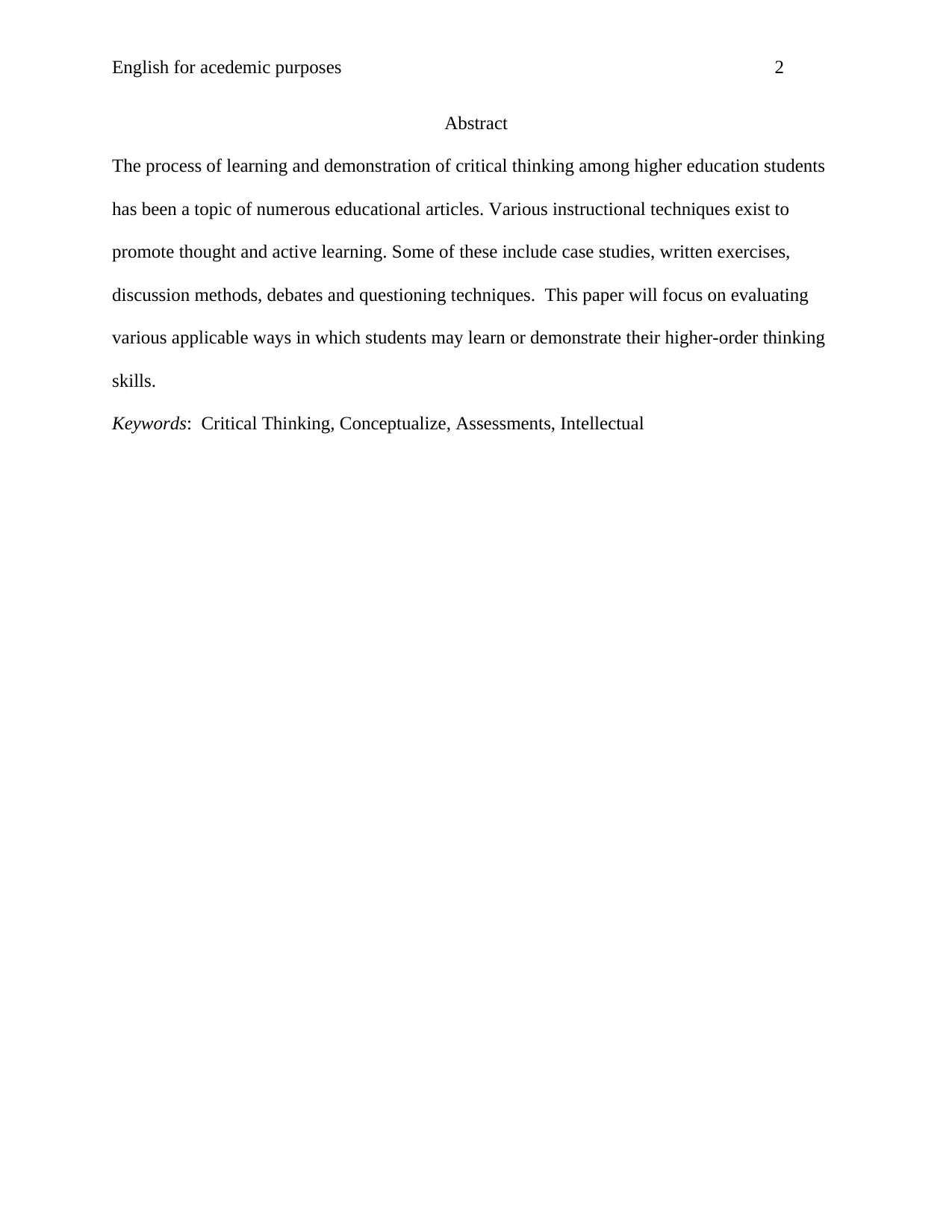
English for acedemic purposes 2
Abstract
The process of learning and demonstration of critical thinking among higher education students
has been a topic of numerous educational articles. Various instructional techniques exist to
promote thought and active learning. Some of these include case studies, written exercises,
discussion methods, debates and questioning techniques. This paper will focus on evaluating
various applicable ways in which students may learn or demonstrate their higher-order thinking
skills.
Keywords: Critical Thinking, Conceptualize, Assessments, Intellectual
Abstract
The process of learning and demonstration of critical thinking among higher education students
has been a topic of numerous educational articles. Various instructional techniques exist to
promote thought and active learning. Some of these include case studies, written exercises,
discussion methods, debates and questioning techniques. This paper will focus on evaluating
various applicable ways in which students may learn or demonstrate their higher-order thinking
skills.
Keywords: Critical Thinking, Conceptualize, Assessments, Intellectual
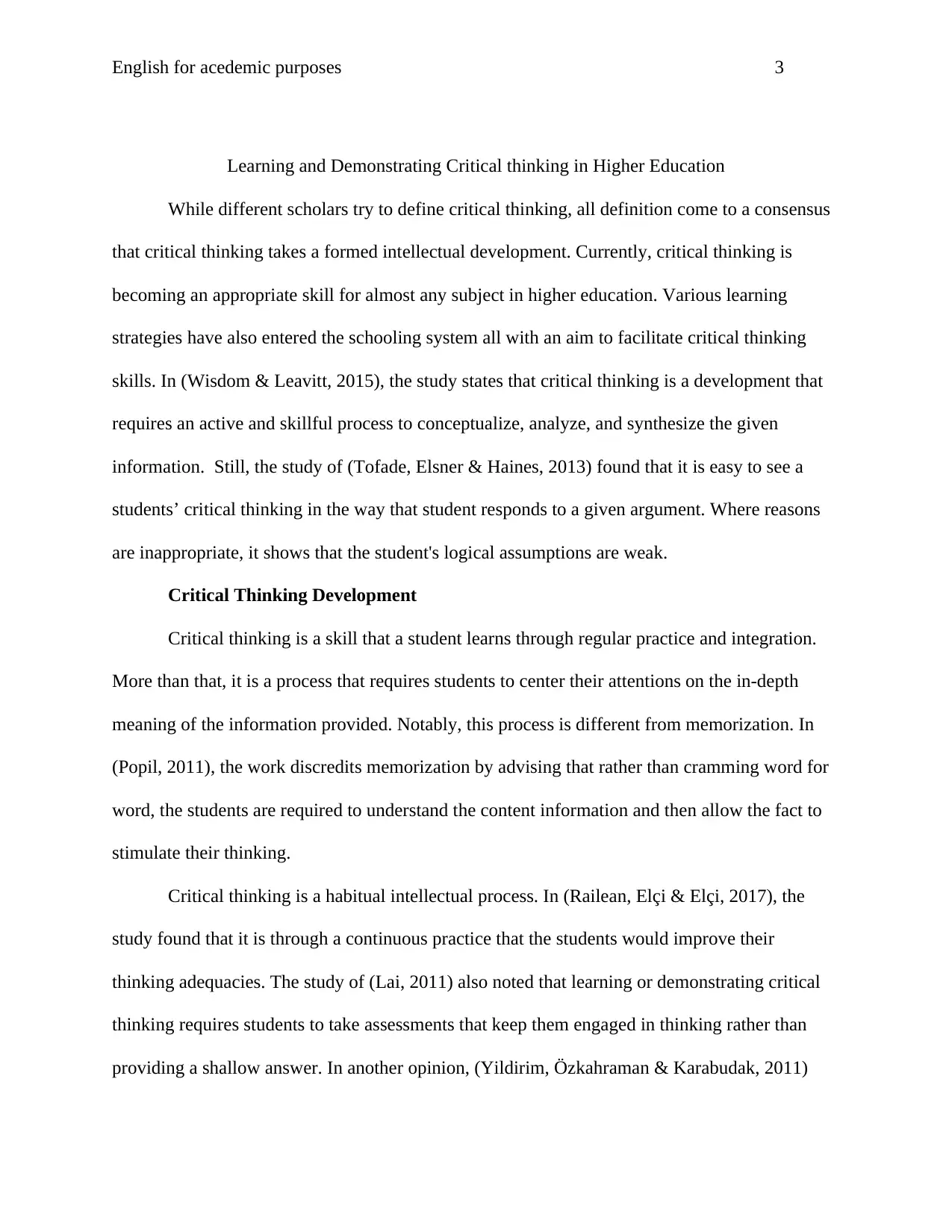
English for acedemic purposes 3
Learning and Demonstrating Critical thinking in Higher Education
While different scholars try to define critical thinking, all definition come to a consensus
that critical thinking takes a formed intellectual development. Currently, critical thinking is
becoming an appropriate skill for almost any subject in higher education. Various learning
strategies have also entered the schooling system all with an aim to facilitate critical thinking
skills. In (Wisdom & Leavitt, 2015), the study states that critical thinking is a development that
requires an active and skillful process to conceptualize, analyze, and synthesize the given
information. Still, the study of (Tofade, Elsner & Haines, 2013) found that it is easy to see a
students’ critical thinking in the way that student responds to a given argument. Where reasons
are inappropriate, it shows that the student's logical assumptions are weak.
Critical Thinking Development
Critical thinking is a skill that a student learns through regular practice and integration.
More than that, it is a process that requires students to center their attentions on the in-depth
meaning of the information provided. Notably, this process is different from memorization. In
(Popil, 2011), the work discredits memorization by advising that rather than cramming word for
word, the students are required to understand the content information and then allow the fact to
stimulate their thinking.
Critical thinking is a habitual intellectual process. In (Railean, Elçi & Elçi, 2017), the
study found that it is through a continuous practice that the students would improve their
thinking adequacies. The study of (Lai, 2011) also noted that learning or demonstrating critical
thinking requires students to take assessments that keep them engaged in thinking rather than
providing a shallow answer. In another opinion, (Yildirim, Özkahraman & Karabudak, 2011)
Learning and Demonstrating Critical thinking in Higher Education
While different scholars try to define critical thinking, all definition come to a consensus
that critical thinking takes a formed intellectual development. Currently, critical thinking is
becoming an appropriate skill for almost any subject in higher education. Various learning
strategies have also entered the schooling system all with an aim to facilitate critical thinking
skills. In (Wisdom & Leavitt, 2015), the study states that critical thinking is a development that
requires an active and skillful process to conceptualize, analyze, and synthesize the given
information. Still, the study of (Tofade, Elsner & Haines, 2013) found that it is easy to see a
students’ critical thinking in the way that student responds to a given argument. Where reasons
are inappropriate, it shows that the student's logical assumptions are weak.
Critical Thinking Development
Critical thinking is a skill that a student learns through regular practice and integration.
More than that, it is a process that requires students to center their attentions on the in-depth
meaning of the information provided. Notably, this process is different from memorization. In
(Popil, 2011), the work discredits memorization by advising that rather than cramming word for
word, the students are required to understand the content information and then allow the fact to
stimulate their thinking.
Critical thinking is a habitual intellectual process. In (Railean, Elçi & Elçi, 2017), the
study found that it is through a continuous practice that the students would improve their
thinking adequacies. The study of (Lai, 2011) also noted that learning or demonstrating critical
thinking requires students to take assessments that keep them engaged in thinking rather than
providing a shallow answer. In another opinion, (Yildirim, Özkahraman & Karabudak, 2011)
⊘ This is a preview!⊘
Do you want full access?
Subscribe today to unlock all pages.

Trusted by 1+ million students worldwide
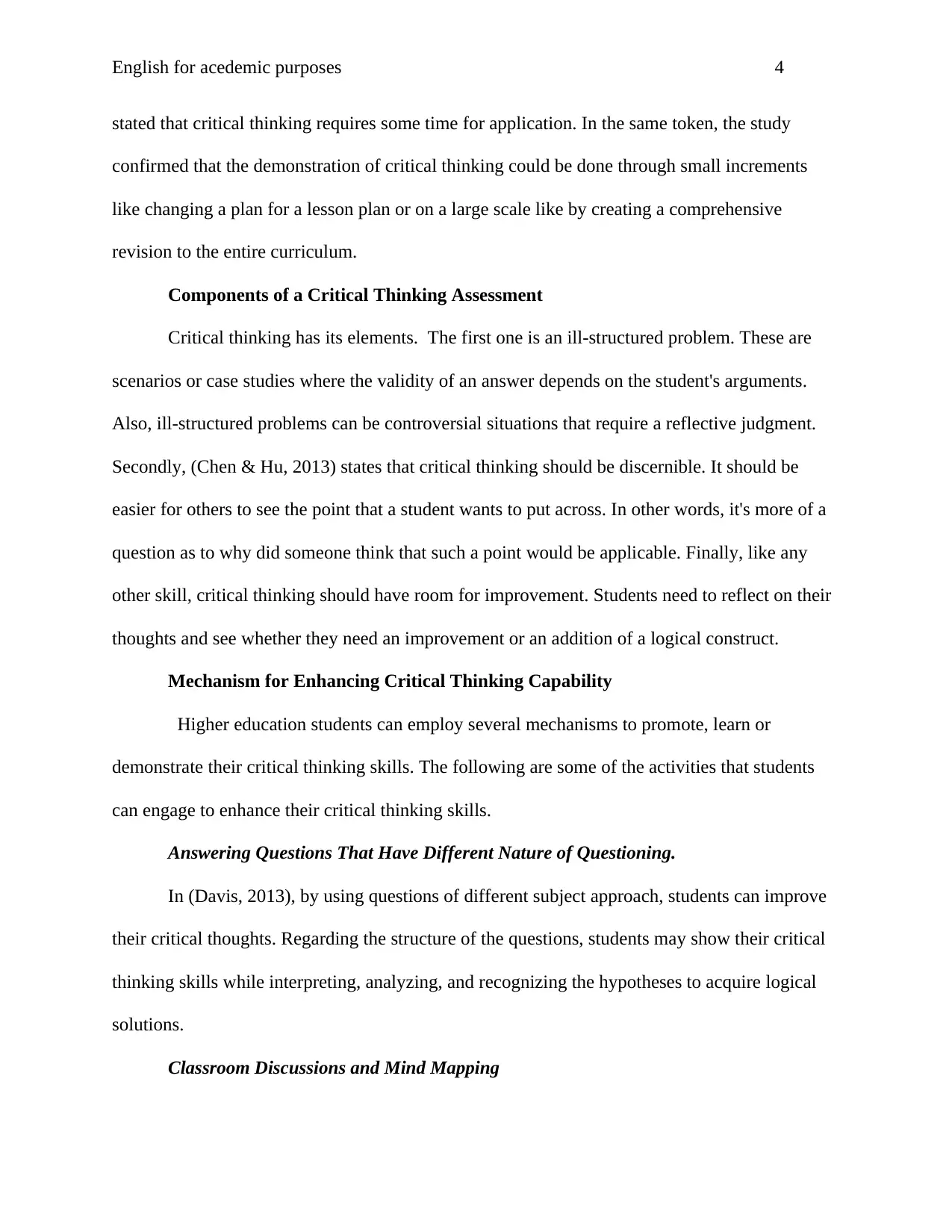
English for acedemic purposes 4
stated that critical thinking requires some time for application. In the same token, the study
confirmed that the demonstration of critical thinking could be done through small increments
like changing a plan for a lesson plan or on a large scale like by creating a comprehensive
revision to the entire curriculum.
Components of a Critical Thinking Assessment
Critical thinking has its elements. The first one is an ill-structured problem. These are
scenarios or case studies where the validity of an answer depends on the student's arguments.
Also, ill-structured problems can be controversial situations that require a reflective judgment.
Secondly, (Chen & Hu, 2013) states that critical thinking should be discernible. It should be
easier for others to see the point that a student wants to put across. In other words, it's more of a
question as to why did someone think that such a point would be applicable. Finally, like any
other skill, critical thinking should have room for improvement. Students need to reflect on their
thoughts and see whether they need an improvement or an addition of a logical construct.
Mechanism for Enhancing Critical Thinking Capability
Higher education students can employ several mechanisms to promote, learn or
demonstrate their critical thinking skills. The following are some of the activities that students
can engage to enhance their critical thinking skills.
Answering Questions That Have Different Nature of Questioning.
In (Davis, 2013), by using questions of different subject approach, students can improve
their critical thoughts. Regarding the structure of the questions, students may show their critical
thinking skills while interpreting, analyzing, and recognizing the hypotheses to acquire logical
solutions.
Classroom Discussions and Mind Mapping
stated that critical thinking requires some time for application. In the same token, the study
confirmed that the demonstration of critical thinking could be done through small increments
like changing a plan for a lesson plan or on a large scale like by creating a comprehensive
revision to the entire curriculum.
Components of a Critical Thinking Assessment
Critical thinking has its elements. The first one is an ill-structured problem. These are
scenarios or case studies where the validity of an answer depends on the student's arguments.
Also, ill-structured problems can be controversial situations that require a reflective judgment.
Secondly, (Chen & Hu, 2013) states that critical thinking should be discernible. It should be
easier for others to see the point that a student wants to put across. In other words, it's more of a
question as to why did someone think that such a point would be applicable. Finally, like any
other skill, critical thinking should have room for improvement. Students need to reflect on their
thoughts and see whether they need an improvement or an addition of a logical construct.
Mechanism for Enhancing Critical Thinking Capability
Higher education students can employ several mechanisms to promote, learn or
demonstrate their critical thinking skills. The following are some of the activities that students
can engage to enhance their critical thinking skills.
Answering Questions That Have Different Nature of Questioning.
In (Davis, 2013), by using questions of different subject approach, students can improve
their critical thoughts. Regarding the structure of the questions, students may show their critical
thinking skills while interpreting, analyzing, and recognizing the hypotheses to acquire logical
solutions.
Classroom Discussions and Mind Mapping
Paraphrase This Document
Need a fresh take? Get an instant paraphrase of this document with our AI Paraphraser
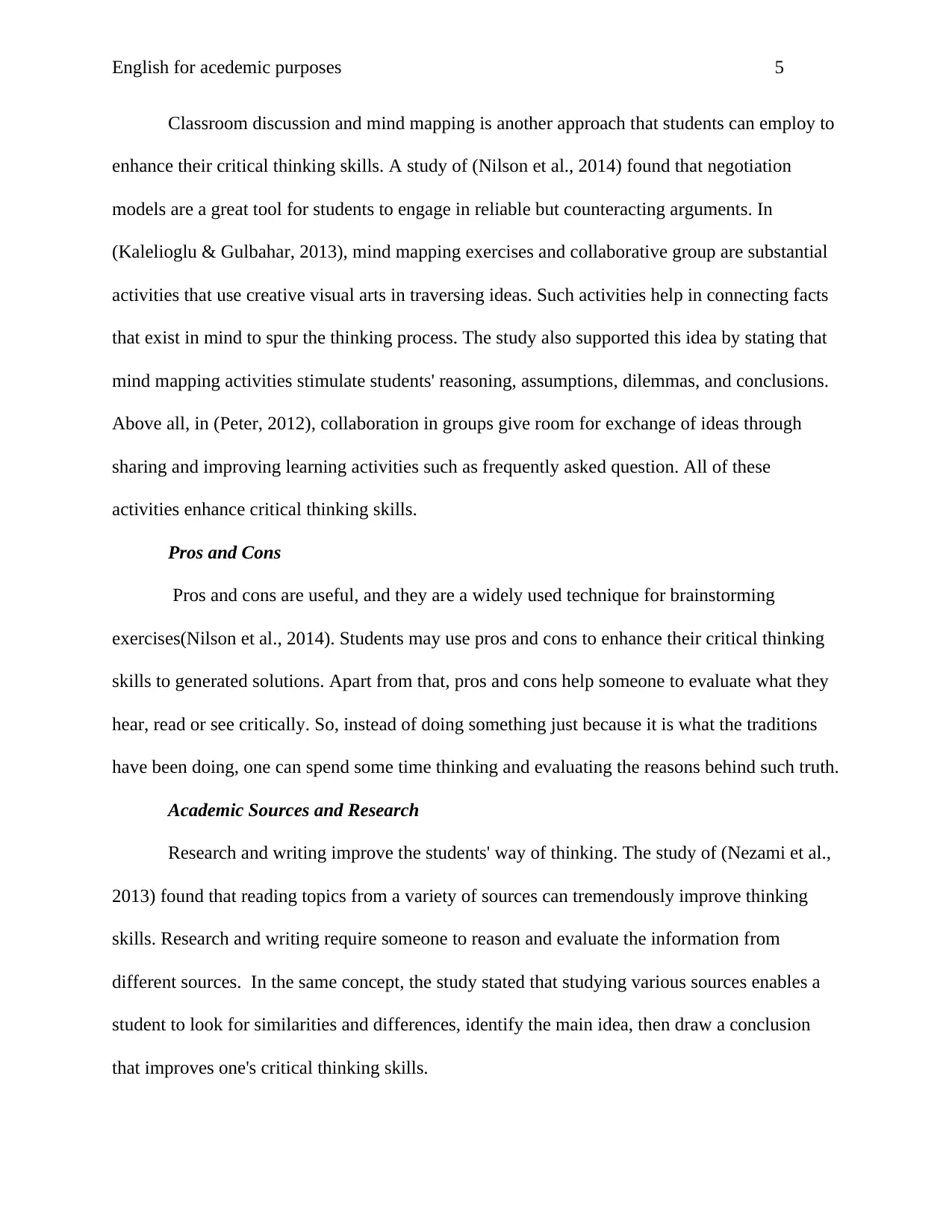
English for acedemic purposes 5
Classroom discussion and mind mapping is another approach that students can employ to
enhance their critical thinking skills. A study of (Nilson et al., 2014) found that negotiation
models are a great tool for students to engage in reliable but counteracting arguments. In
(Kalelioglu & Gulbahar, 2013), mind mapping exercises and collaborative group are substantial
activities that use creative visual arts in traversing ideas. Such activities help in connecting facts
that exist in mind to spur the thinking process. The study also supported this idea by stating that
mind mapping activities stimulate students' reasoning, assumptions, dilemmas, and conclusions.
Above all, in (Peter, 2012), collaboration in groups give room for exchange of ideas through
sharing and improving learning activities such as frequently asked question. All of these
activities enhance critical thinking skills.
Pros and Cons
Pros and cons are useful, and they are a widely used technique for brainstorming
exercises(Nilson et al., 2014). Students may use pros and cons to enhance their critical thinking
skills to generated solutions. Apart from that, pros and cons help someone to evaluate what they
hear, read or see critically. So, instead of doing something just because it is what the traditions
have been doing, one can spend some time thinking and evaluating the reasons behind such truth.
Academic Sources and Research
Research and writing improve the students' way of thinking. The study of (Nezami et al.,
2013) found that reading topics from a variety of sources can tremendously improve thinking
skills. Research and writing require someone to reason and evaluate the information from
different sources. In the same concept, the study stated that studying various sources enables a
student to look for similarities and differences, identify the main idea, then draw a conclusion
that improves one's critical thinking skills.
Classroom discussion and mind mapping is another approach that students can employ to
enhance their critical thinking skills. A study of (Nilson et al., 2014) found that negotiation
models are a great tool for students to engage in reliable but counteracting arguments. In
(Kalelioglu & Gulbahar, 2013), mind mapping exercises and collaborative group are substantial
activities that use creative visual arts in traversing ideas. Such activities help in connecting facts
that exist in mind to spur the thinking process. The study also supported this idea by stating that
mind mapping activities stimulate students' reasoning, assumptions, dilemmas, and conclusions.
Above all, in (Peter, 2012), collaboration in groups give room for exchange of ideas through
sharing and improving learning activities such as frequently asked question. All of these
activities enhance critical thinking skills.
Pros and Cons
Pros and cons are useful, and they are a widely used technique for brainstorming
exercises(Nilson et al., 2014). Students may use pros and cons to enhance their critical thinking
skills to generated solutions. Apart from that, pros and cons help someone to evaluate what they
hear, read or see critically. So, instead of doing something just because it is what the traditions
have been doing, one can spend some time thinking and evaluating the reasons behind such truth.
Academic Sources and Research
Research and writing improve the students' way of thinking. The study of (Nezami et al.,
2013) found that reading topics from a variety of sources can tremendously improve thinking
skills. Research and writing require someone to reason and evaluate the information from
different sources. In the same concept, the study stated that studying various sources enables a
student to look for similarities and differences, identify the main idea, then draw a conclusion
that improves one's critical thinking skills.
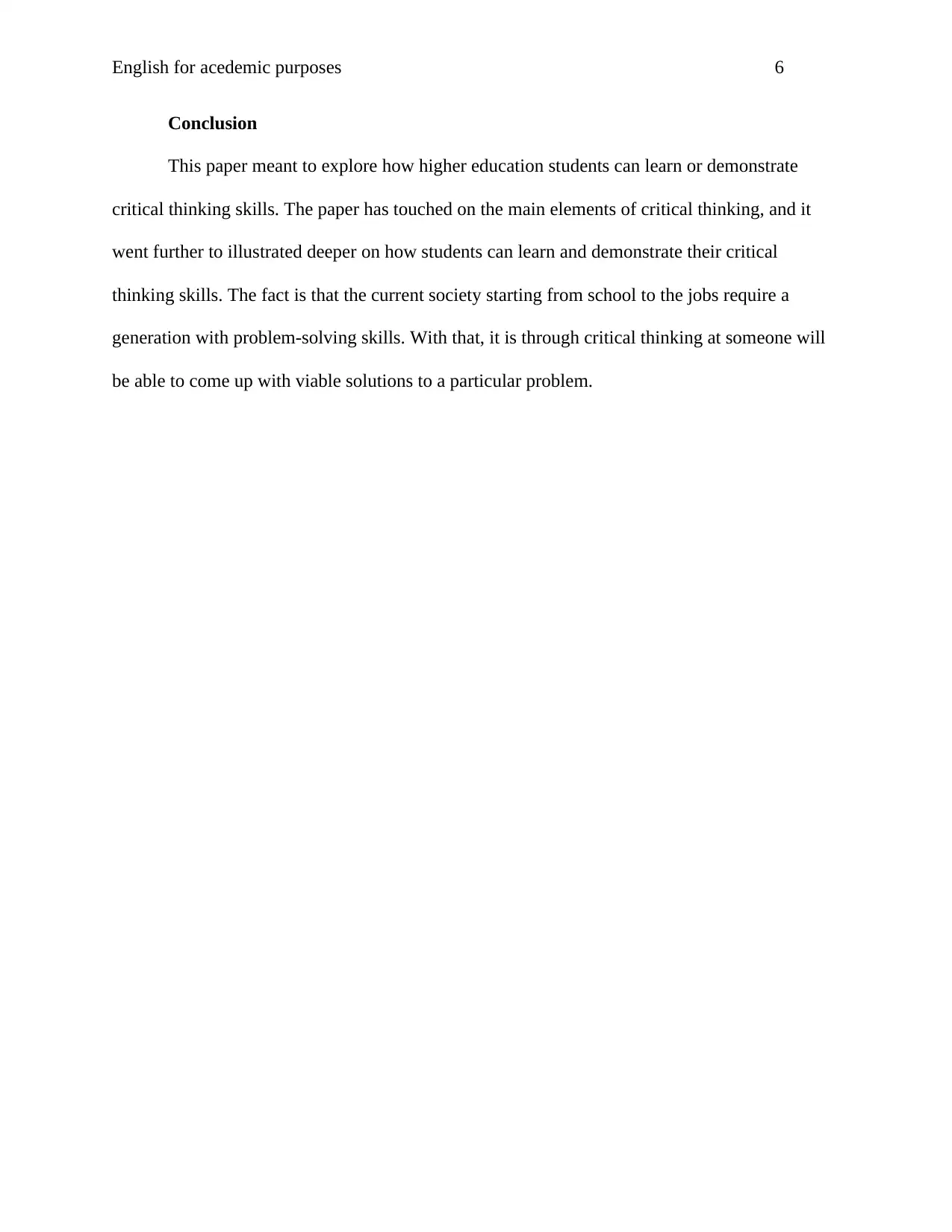
English for acedemic purposes 6
Conclusion
This paper meant to explore how higher education students can learn or demonstrate
critical thinking skills. The paper has touched on the main elements of critical thinking, and it
went further to illustrated deeper on how students can learn and demonstrate their critical
thinking skills. The fact is that the current society starting from school to the jobs require a
generation with problem-solving skills. With that, it is through critical thinking at someone will
be able to come up with viable solutions to a particular problem.
Conclusion
This paper meant to explore how higher education students can learn or demonstrate
critical thinking skills. The paper has touched on the main elements of critical thinking, and it
went further to illustrated deeper on how students can learn and demonstrate their critical
thinking skills. The fact is that the current society starting from school to the jobs require a
generation with problem-solving skills. With that, it is through critical thinking at someone will
be able to come up with viable solutions to a particular problem.
⊘ This is a preview!⊘
Do you want full access?
Subscribe today to unlock all pages.

Trusted by 1+ million students worldwide
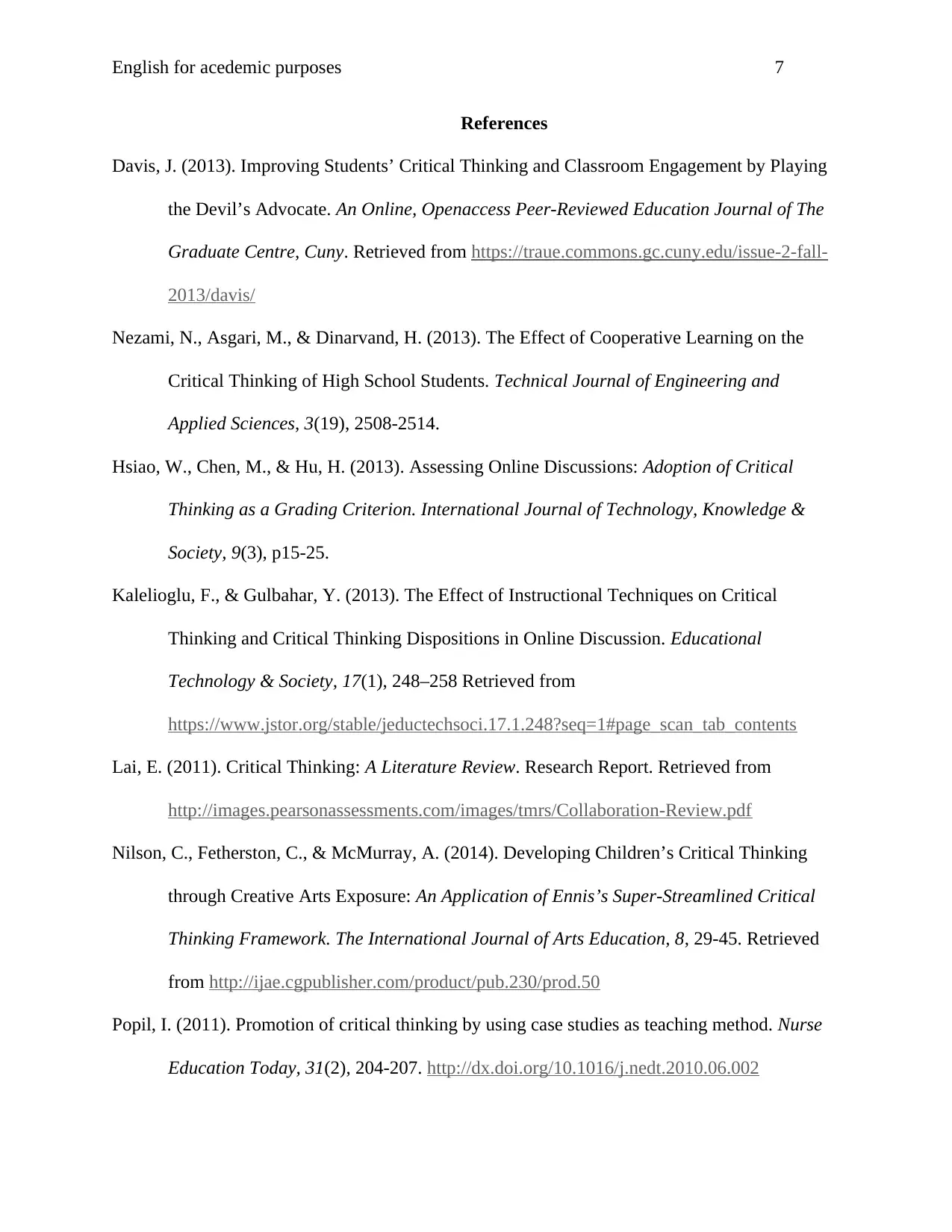
English for acedemic purposes 7
References
Davis, J. (2013). Improving Students’ Critical Thinking and Classroom Engagement by Playing
the Devil’s Advocate. An Online, Openaccess Peer-Reviewed Education Journal of The
Graduate Centre, Cuny. Retrieved from https://traue.commons.gc.cuny.edu/issue-2-fall-
2013/davis/
Nezami, N., Asgari, M., & Dinarvand, H. (2013). The Effect of Cooperative Learning on the
Critical Thinking of High School Students. Technical Journal of Engineering and
Applied Sciences, 3(19), 2508-2514.
Hsiao, W., Chen, M., & Hu, H. (2013). Assessing Online Discussions: Adoption of Critical
Thinking as a Grading Criterion. International Journal of Technology, Knowledge &
Society, 9(3), p15-25.
Kalelioglu, F., & Gulbahar, Y. (2013). The Effect of Instructional Techniques on Critical
Thinking and Critical Thinking Dispositions in Online Discussion. Educational
Technology & Society, 17(1), 248–258 Retrieved from
https://www.jstor.org/stable/jeductechsoci.17.1.248?seq=1#page_scan_tab_contents
Lai, E. (2011). Critical Thinking: A Literature Review. Research Report. Retrieved from
http://images.pearsonassessments.com/images/tmrs/Collaboration-Review.pdf
Nilson, C., Fetherston, C., & McMurray, A. (2014). Developing Children’s Critical Thinking
through Creative Arts Exposure: An Application of Ennis’s Super-Streamlined Critical
Thinking Framework. The International Journal of Arts Education, 8, 29-45. Retrieved
from http://ijae.cgpublisher.com/product/pub.230/prod.50
Popil, I. (2011). Promotion of critical thinking by using case studies as teaching method. Nurse
Education Today, 31(2), 204-207. http://dx.doi.org/10.1016/j.nedt.2010.06.002
References
Davis, J. (2013). Improving Students’ Critical Thinking and Classroom Engagement by Playing
the Devil’s Advocate. An Online, Openaccess Peer-Reviewed Education Journal of The
Graduate Centre, Cuny. Retrieved from https://traue.commons.gc.cuny.edu/issue-2-fall-
2013/davis/
Nezami, N., Asgari, M., & Dinarvand, H. (2013). The Effect of Cooperative Learning on the
Critical Thinking of High School Students. Technical Journal of Engineering and
Applied Sciences, 3(19), 2508-2514.
Hsiao, W., Chen, M., & Hu, H. (2013). Assessing Online Discussions: Adoption of Critical
Thinking as a Grading Criterion. International Journal of Technology, Knowledge &
Society, 9(3), p15-25.
Kalelioglu, F., & Gulbahar, Y. (2013). The Effect of Instructional Techniques on Critical
Thinking and Critical Thinking Dispositions in Online Discussion. Educational
Technology & Society, 17(1), 248–258 Retrieved from
https://www.jstor.org/stable/jeductechsoci.17.1.248?seq=1#page_scan_tab_contents
Lai, E. (2011). Critical Thinking: A Literature Review. Research Report. Retrieved from
http://images.pearsonassessments.com/images/tmrs/Collaboration-Review.pdf
Nilson, C., Fetherston, C., & McMurray, A. (2014). Developing Children’s Critical Thinking
through Creative Arts Exposure: An Application of Ennis’s Super-Streamlined Critical
Thinking Framework. The International Journal of Arts Education, 8, 29-45. Retrieved
from http://ijae.cgpublisher.com/product/pub.230/prod.50
Popil, I. (2011). Promotion of critical thinking by using case studies as teaching method. Nurse
Education Today, 31(2), 204-207. http://dx.doi.org/10.1016/j.nedt.2010.06.002
Paraphrase This Document
Need a fresh take? Get an instant paraphrase of this document with our AI Paraphraser
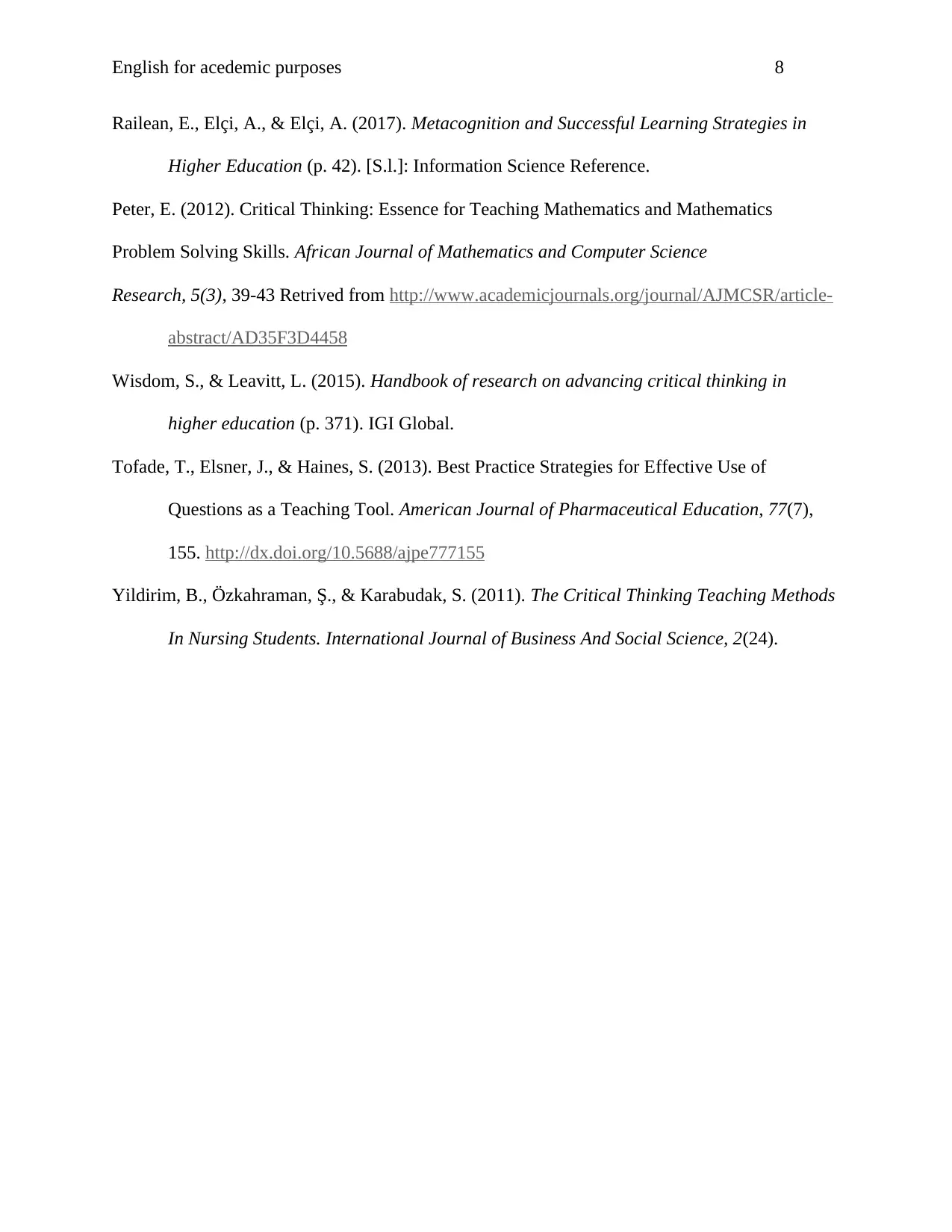
English for acedemic purposes 8
Railean, E., Elçi, A., & Elçi, A. (2017). Metacognition and Successful Learning Strategies in
Higher Education (p. 42). [S.l.]: Information Science Reference.
Peter, E. (2012). Critical Thinking: Essence for Teaching Mathematics and Mathematics
Problem Solving Skills. African Journal of Mathematics and Computer Science
Research, 5(3), 39-43 Retrived from http://www.academicjournals.org/journal/AJMCSR/article-
abstract/AD35F3D4458
Wisdom, S., & Leavitt, L. (2015). Handbook of research on advancing critical thinking in
higher education (p. 371). IGI Global.
Tofade, T., Elsner, J., & Haines, S. (2013). Best Practice Strategies for Effective Use of
Questions as a Teaching Tool. American Journal of Pharmaceutical Education, 77(7),
155. http://dx.doi.org/10.5688/ajpe777155
Yildirim, B., Özkahraman, Ş., & Karabudak, S. (2011). The Critical Thinking Teaching Methods
In Nursing Students. International Journal of Business And Social Science, 2(24).
Railean, E., Elçi, A., & Elçi, A. (2017). Metacognition and Successful Learning Strategies in
Higher Education (p. 42). [S.l.]: Information Science Reference.
Peter, E. (2012). Critical Thinking: Essence for Teaching Mathematics and Mathematics
Problem Solving Skills. African Journal of Mathematics and Computer Science
Research, 5(3), 39-43 Retrived from http://www.academicjournals.org/journal/AJMCSR/article-
abstract/AD35F3D4458
Wisdom, S., & Leavitt, L. (2015). Handbook of research on advancing critical thinking in
higher education (p. 371). IGI Global.
Tofade, T., Elsner, J., & Haines, S. (2013). Best Practice Strategies for Effective Use of
Questions as a Teaching Tool. American Journal of Pharmaceutical Education, 77(7),
155. http://dx.doi.org/10.5688/ajpe777155
Yildirim, B., Özkahraman, Ş., & Karabudak, S. (2011). The Critical Thinking Teaching Methods
In Nursing Students. International Journal of Business And Social Science, 2(24).
1 out of 8
Related Documents
Your All-in-One AI-Powered Toolkit for Academic Success.
+13062052269
info@desklib.com
Available 24*7 on WhatsApp / Email
![[object Object]](/_next/static/media/star-bottom.7253800d.svg)
Unlock your academic potential
Copyright © 2020–2025 A2Z Services. All Rights Reserved. Developed and managed by ZUCOL.




